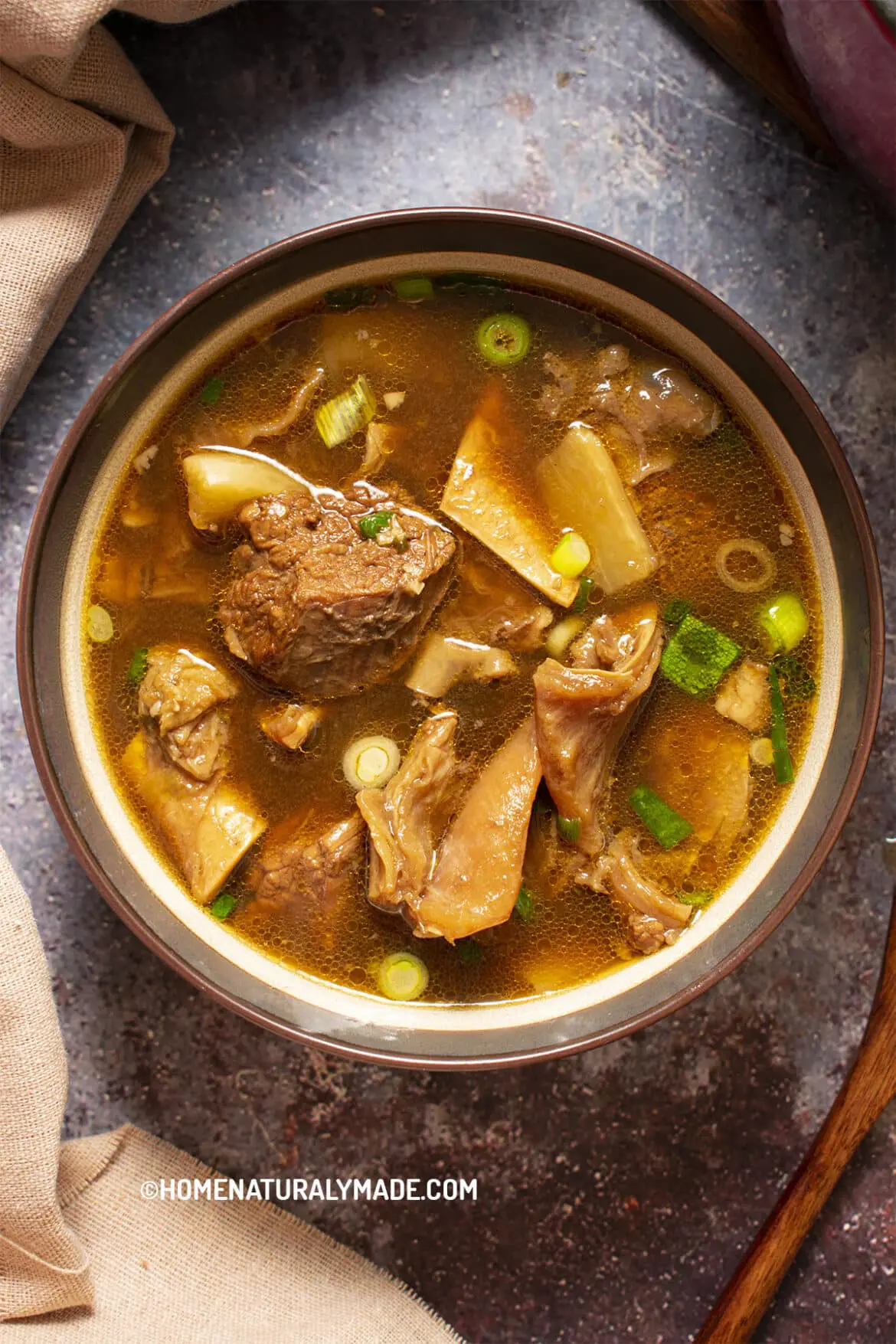Table of Contents
Luo Bo Niu Nan {萝卜牛腩}, or Beef Brisket and Daikon Radish is a classic Cantonese dish featuring beef with vegetables. A popular Chinese restaurant takeout item in the west, Cantonese Beef Brisket with Daikon Radish boasts soft delicious beef brisket braised together with daikon radish in a naturally yummy broth. Add this to a bed of freshly steamed rice or bowl of noodle soup for a satisfying meal.
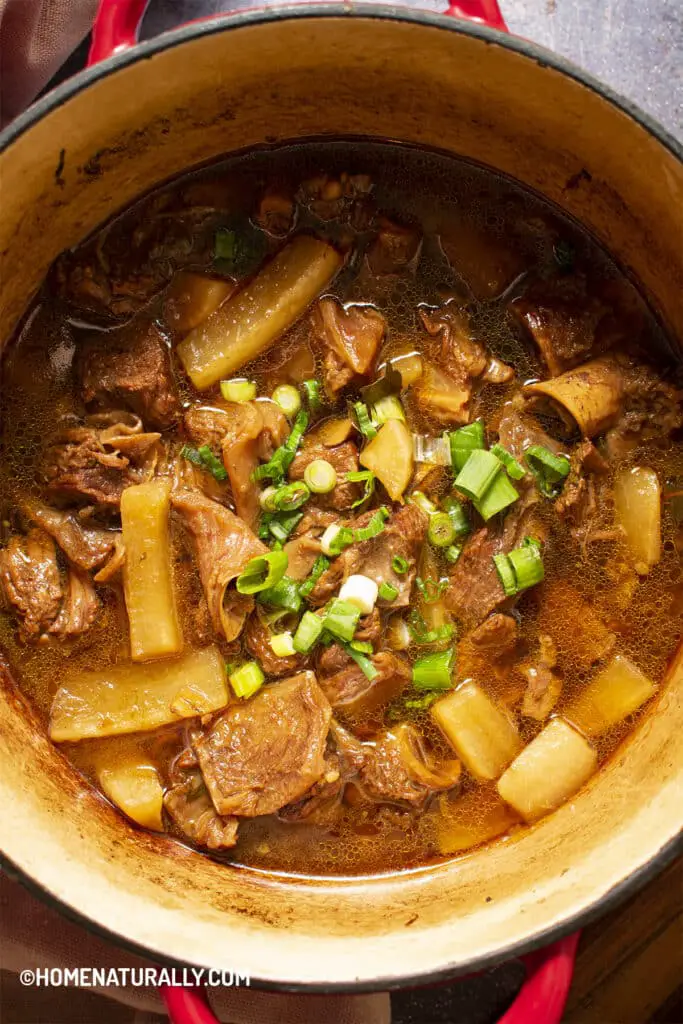
How to make Cantonese Beef Brisket and Daikon Radish yummy, easy and healthy?
Tip No.1 is to prepare a naturally tasty seasoning package for Luo Bo Niu Nan
As expected, the three primary Chinese cooking herbs, i.e., green onion, ginger, and garlic cloves complement the beef so well. Shaoxing wine and soy sauce are there to further tenderize and flavor the beef wonderfully.
For the spices, star anise, cinnamon, black pepper, Sichuan chili powder, and bay leaves, all in powder form, except for the bay leaves, work magically together to create this sensational flavor and taste. A pinch of sugar just to make the flavor pop.

Cut green onion, garlic, and ginger into small pieces. Mix and blend the spices together. Mix the light soy sauce and Shaoxing wine well together.
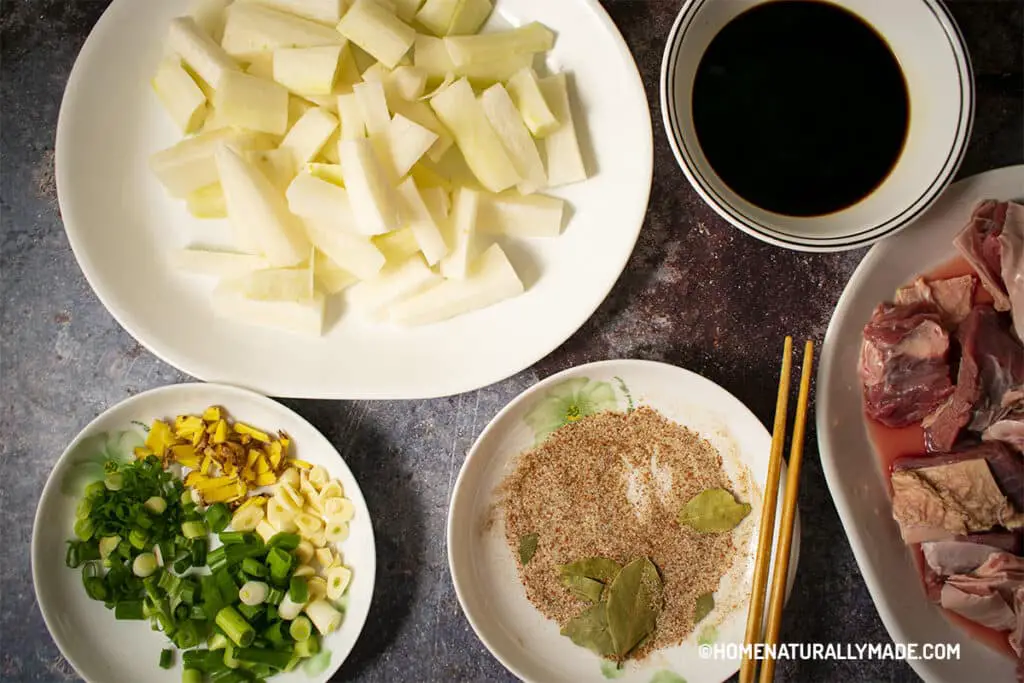
Tip No.2 is to sear Beef Brisket before braising
Beef Brisket is a cut of meat from the lower chest of beef, featuring lean muscle meat surrounded by a sheet of connective tissue collagen. The slow cooking breaks down and softens the connective tissue nicely. This, coupled with the contrasting lean muscle meat, makes the Beef Brisket extremely yummy.
The first thing first is to cut the beef brisket into bite-size chunks and soak it in the cold water for about 30 minutes before cooking to get rid of the trapped blood. Rinse a a couple of times and pat dry with a paper towl.
By the way, beef brisket is tough to cut because of the connective tissue collagen. Use a Chinese butcher cleaver coupled with a thick hardwood cutting board to chop the beef brisket. Or you can ask your butcher to do that for you.
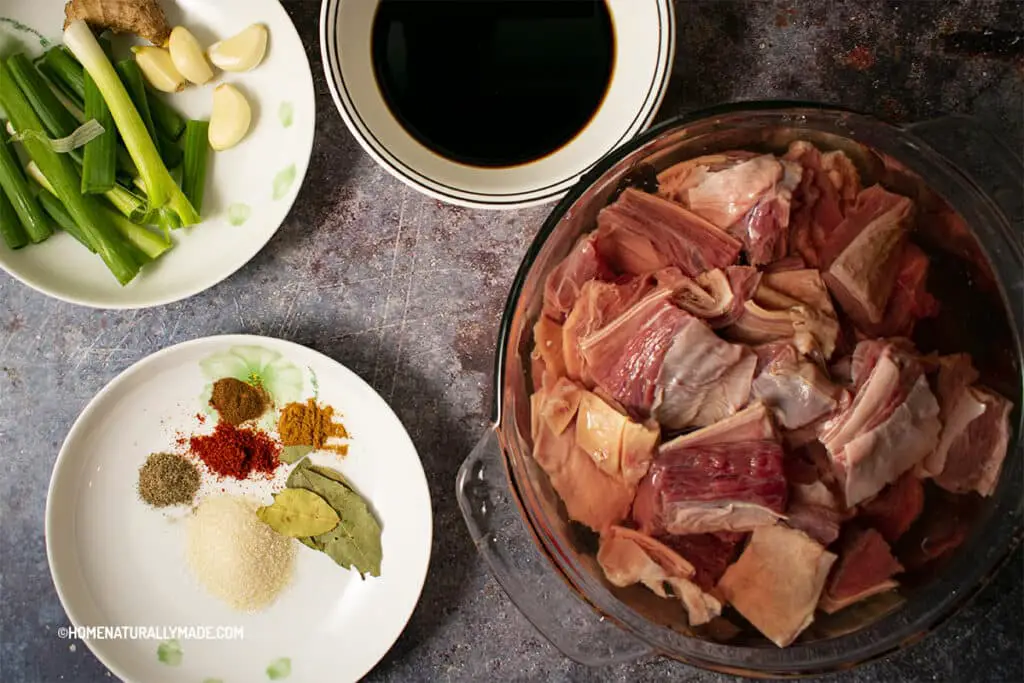
A cast iron dutch oven or large clay pot is great for cooking Cantonese Beef Brisket and Daikon Radish for their superor capabilities of retening heat. Turn the heat to medium, heat a cast iron dutch oven for 1 minute, and then add the chopped green onion and ginger, along with the beef brisket chunks.
Nonstop flip and turn the beef brisket and cook for about 4 minutes. Sprinkle the spice mix over the beef brisket and flip and turn for another about 3 minutes.
Following that, pour the soy sauce and Shaoxing wine mixture over the beef brisket in a circular motion, and continue to flip and turn for about 4 minutes.
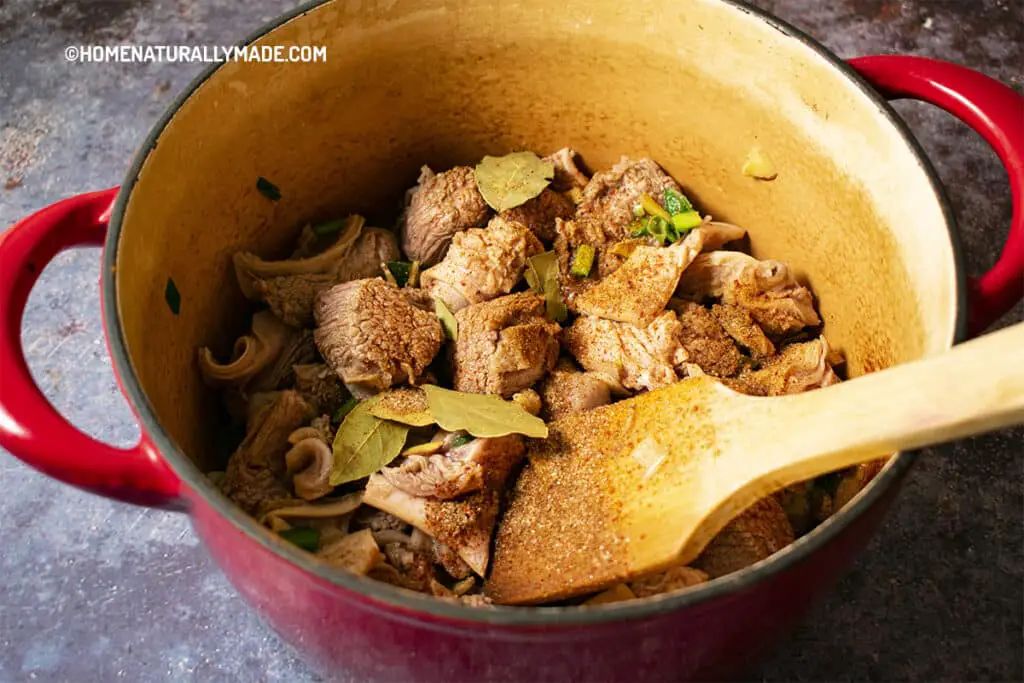
Tip No.3 is to blanch daikon radish first before braising
Fill a 4 Qt stockpot with water and bring it to a boil. Add the daikon radish bite-size strips and bring it to a boil again.
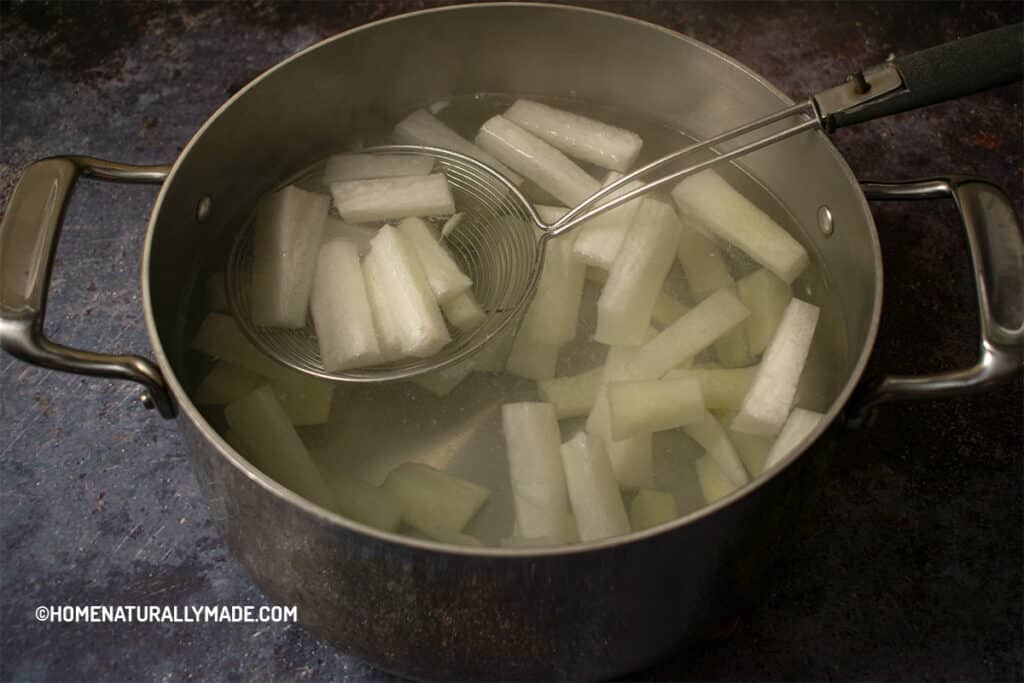
Tip No.4 is to slow cook beef brisket first and then add daikon radish and continue the slow cook
Patience is the key here. Simmer beef brisket for 1.5 hours, and then add daikon radish and simmer for another 1.5 hours.
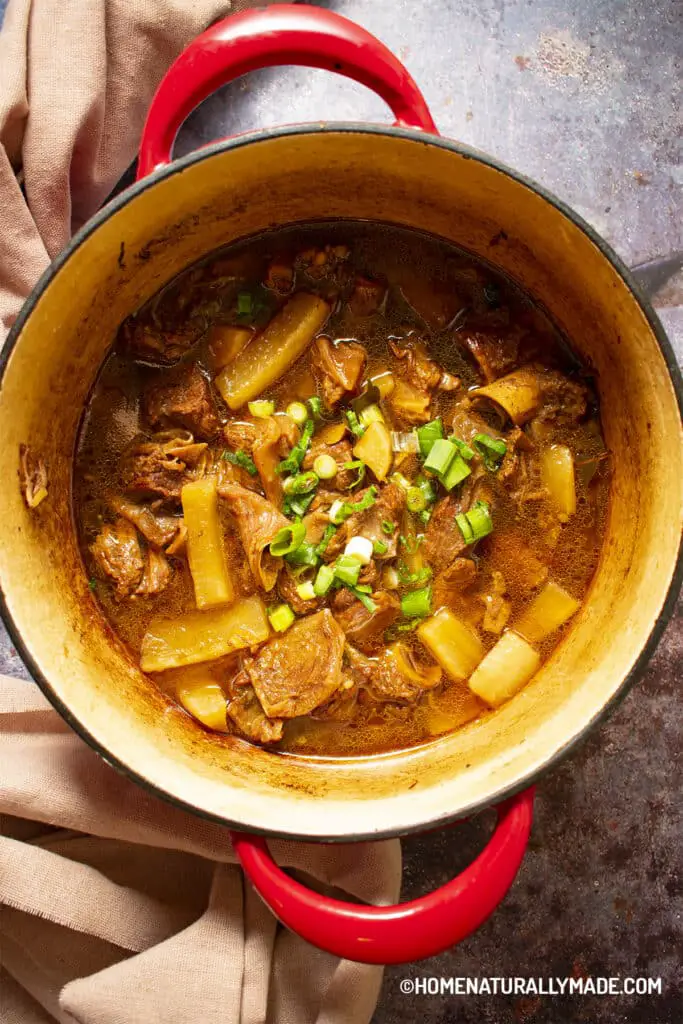
Last but not least is use medium-high heat to wrap up the cooking
Following 3 hours of simmering, turn the heat to medium-high, mix everything well in the dutch oven and cook for 10 minutes. It is a typical Chinese cooking technique that we simmer or slow cook the food to soften them from the inside out and then uses medium-high heat to caramelize the outside and thicken the broth a little bit at the same time.
All done! Enjoy a super delicious Cantonese Luo Bo Niu Nan {Beef Brisket with Daikon Radish}.
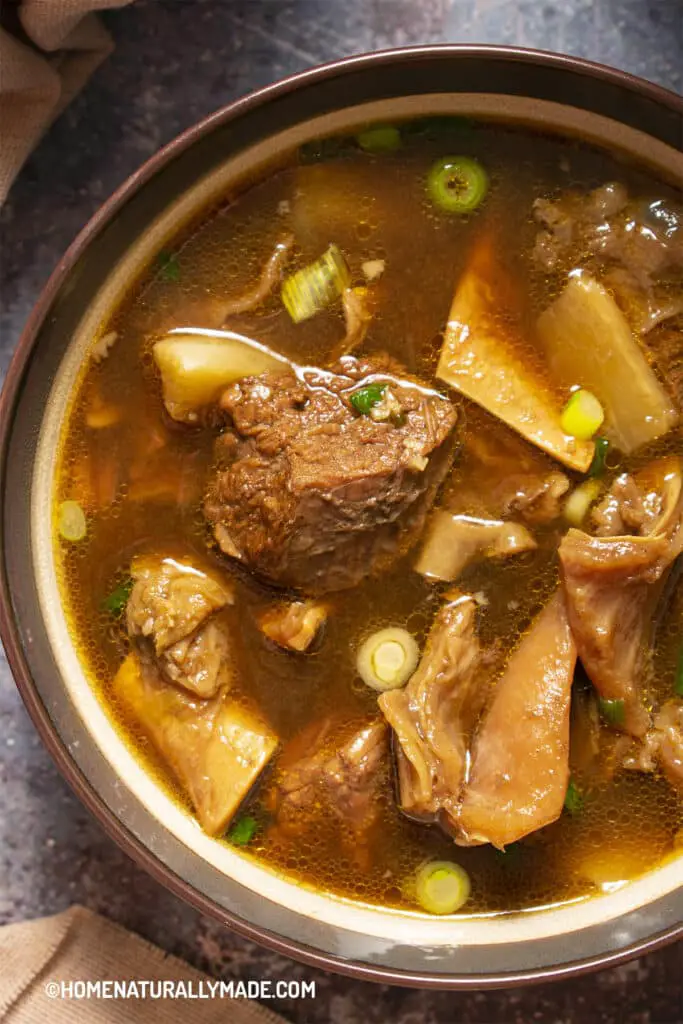
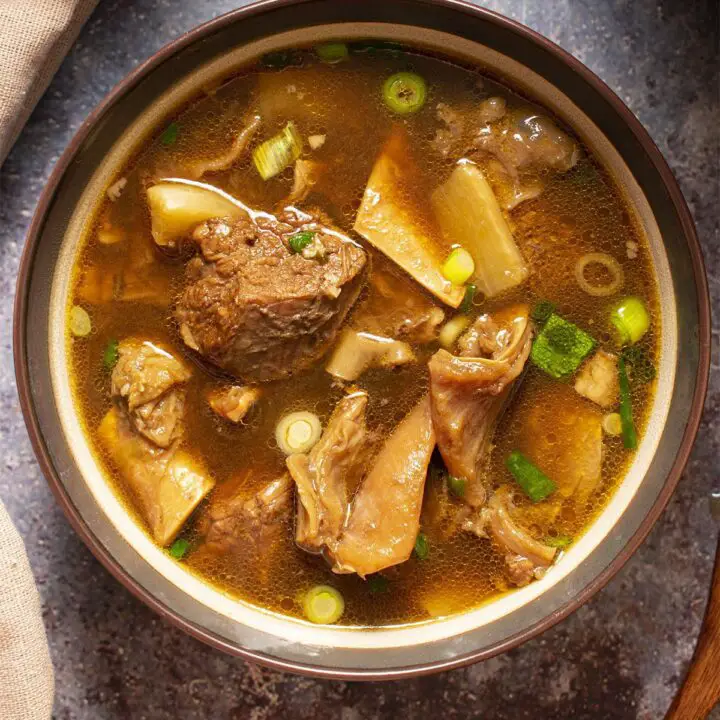
Luo Bo Niu Nan {Cantonese Style Beef Brisket with Daikon Radish} Recipe
Luo Bo Niu Nan {萝卜牛腩}, or Beef Brisket and Daikon Radish is a classic Cantonese dish. A popular Chinese restaurant takeout item in the west, Cantonese Beef Brisket with Daikon Radish features soft delicious beef brisket braised together with daikon radish in a naturally yummy broth.
Ingredients
- 2 lb Beef Brisket
- 1.2 lb Daikon Radish
- 2 tbsp Shaoxing wine
- 2 tbsp Light Soy Sauce
- 1 tbsp Naturally aged soy sauce, or dark soy sauce
- 1/4 tsp star anise powder
- 1/4 tsp cinnamon powder
- 1/4 tsp Sichuan chili powder
- 1/4 tsp black pepper, freshly ground
- 4 bay leaves
- 2 tsp cane sugar, organic unrefined preferred
- 4 garlic cloves
- A small piece of ginger, about 8 g, thinly sliced
- 2 stalks of green onion, chopped
- 6 cups of boiling water
Instructions
Prep Work:
- Gather ingredients.
- Cut the beef brisket into bite-size chunks and soak them in cold water for about 20 minutes. Rinse a few times and pat dry.
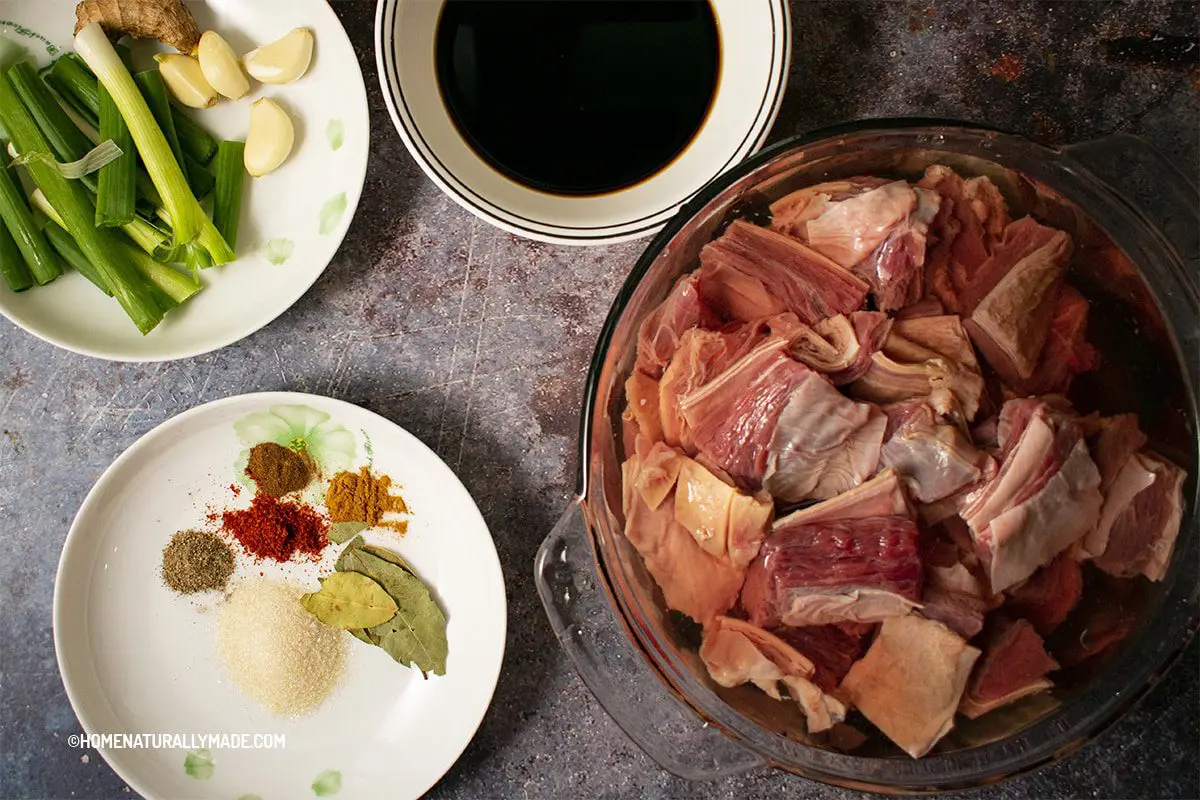
- Cut ginger and garlic into thin slices, and chop the green onion into small pieces.
- Wash and rinse daikon radish well, peel using a peeler, and then cut into long bite-size pieces. Mix the spice well together.
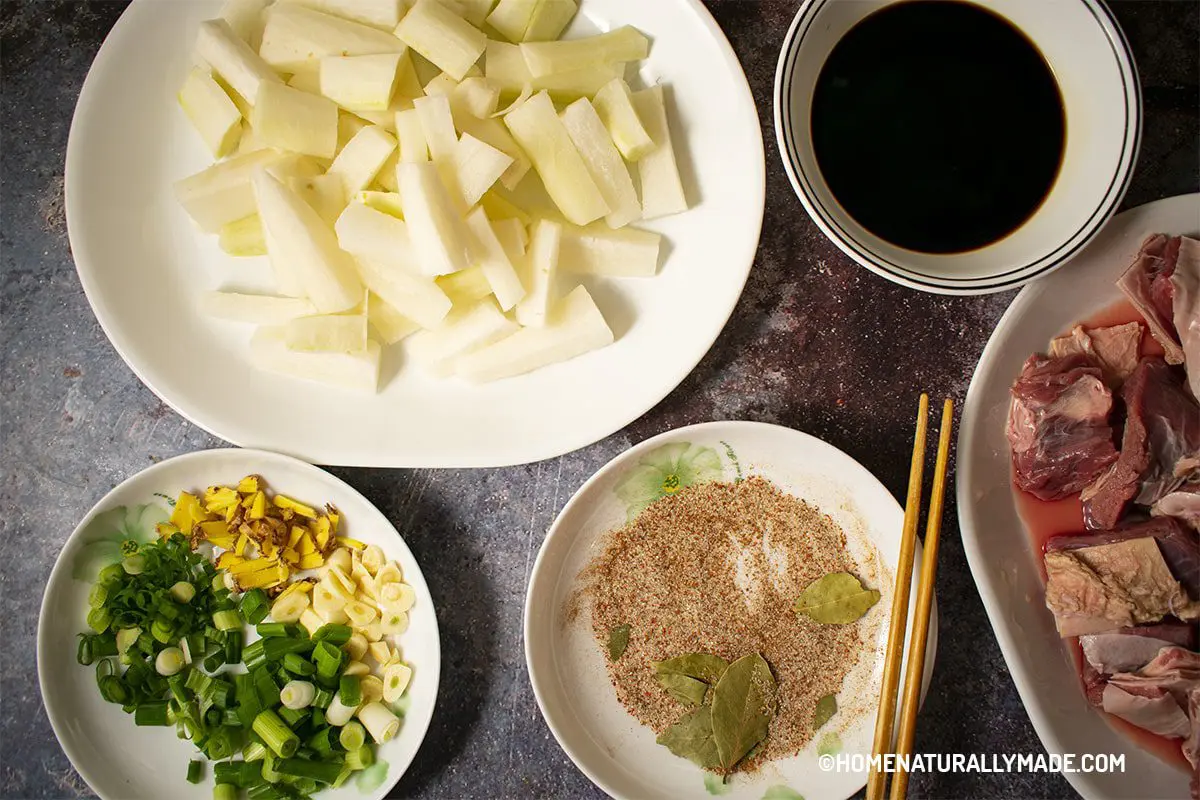
- Fill a stockpot with water, cover the pot with a lid and bring to a boil. Add the Daikon Radish, cover the pot with a lid, and wait for it to reach a boil again.
- Turn off the heat, remove the Daikon radish from the stockpot using a stainless steel skimmer and set it aside.
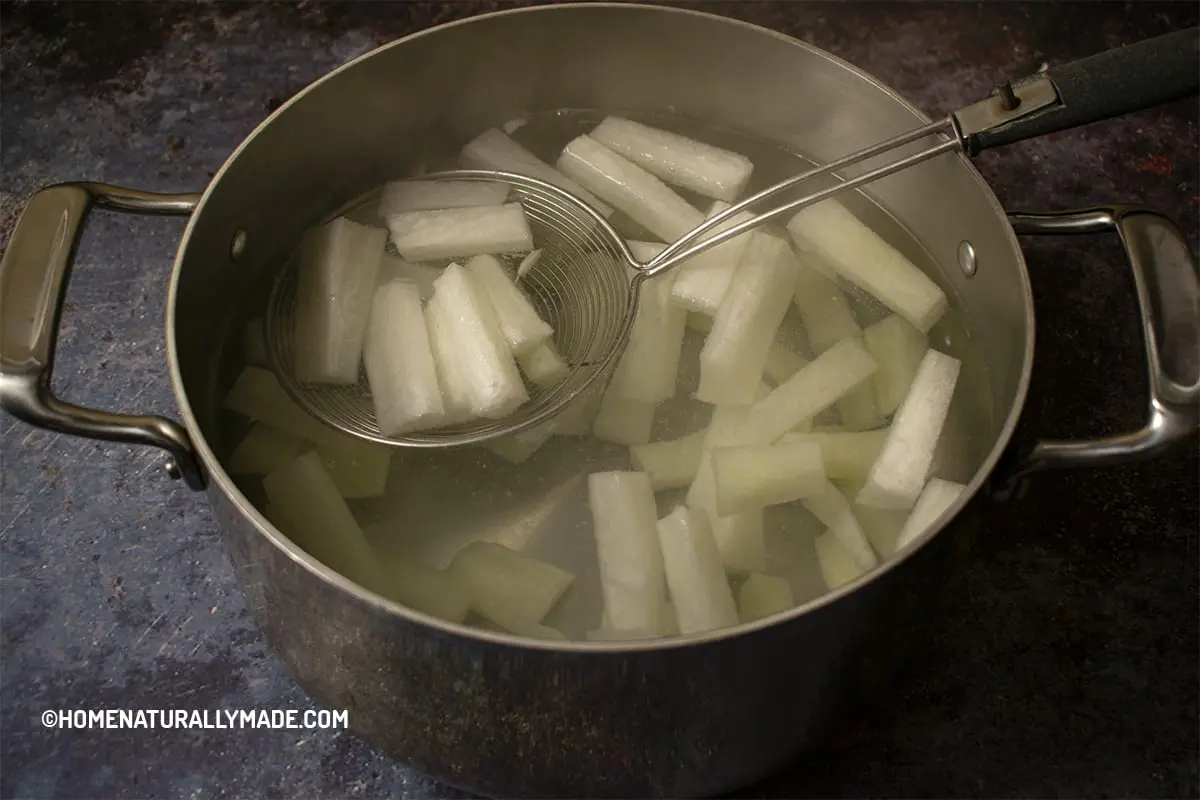
- Use a kettle or stockpot to boil some hot water. We will need 6 cups.
Sear the Beef Brisket:
- Turn the heat to medium and heat a dutch oven for 1 minute and then add green onion, and ginger along with the beef brisket. Flip, turn, and cook for about 4 minutes.
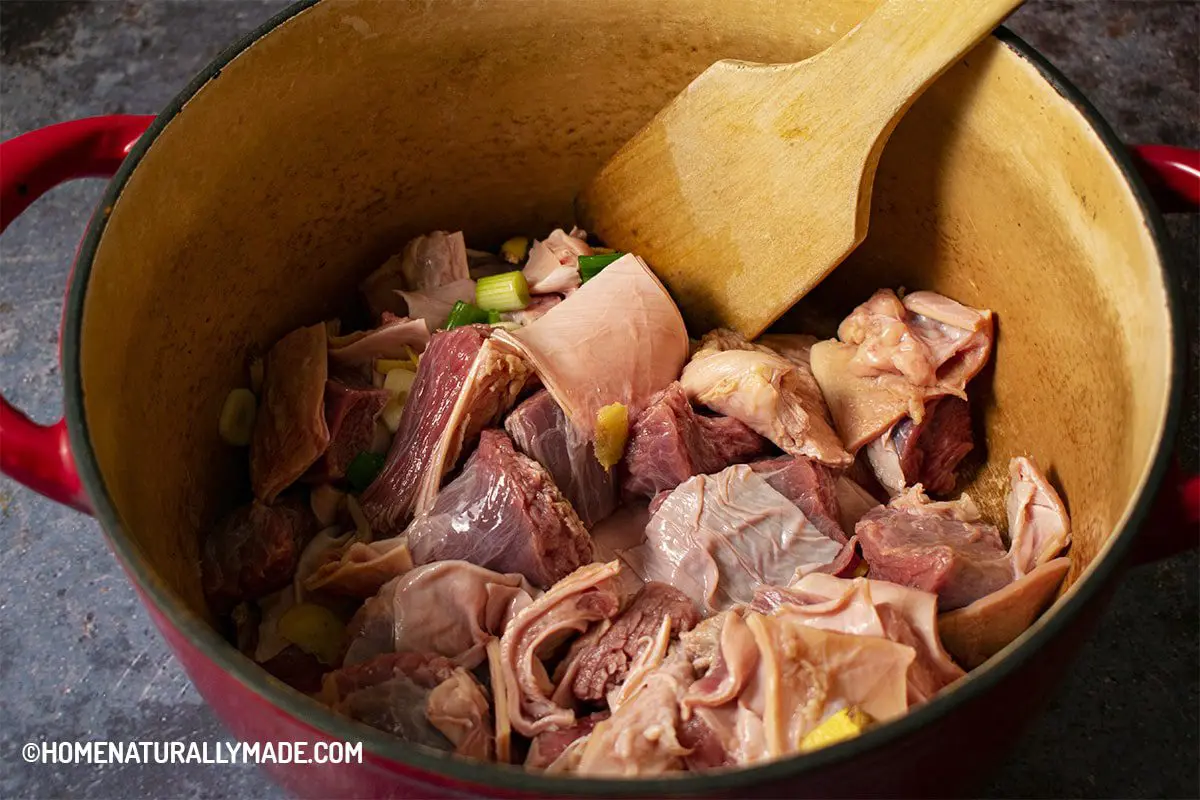
- Sprinkle the spice mixture over the beef brisket and continue to flip, turn and cook for another 3 minutes or so.

- Pour the soy sauce and Shaoxing wine mixture over the beef brisket in a circular motion and continue to flip, turn and cook for another 3 minutes or so.
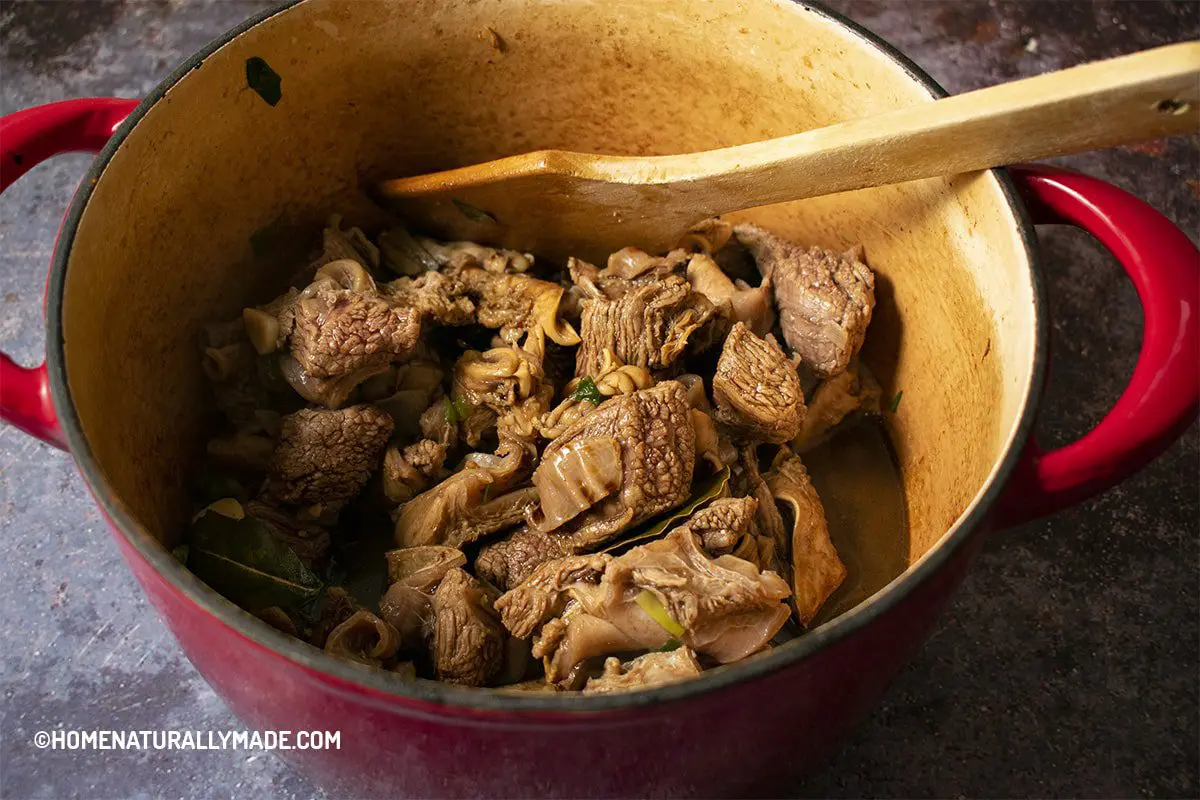
Simmer the Beef Brisket with Daikon Radish:
- Add 6 cups of boiling water, mix everything well in the dutch oven, cover it with the lid, and wait for the whole thing to reach a boil again. About 5 minutes.
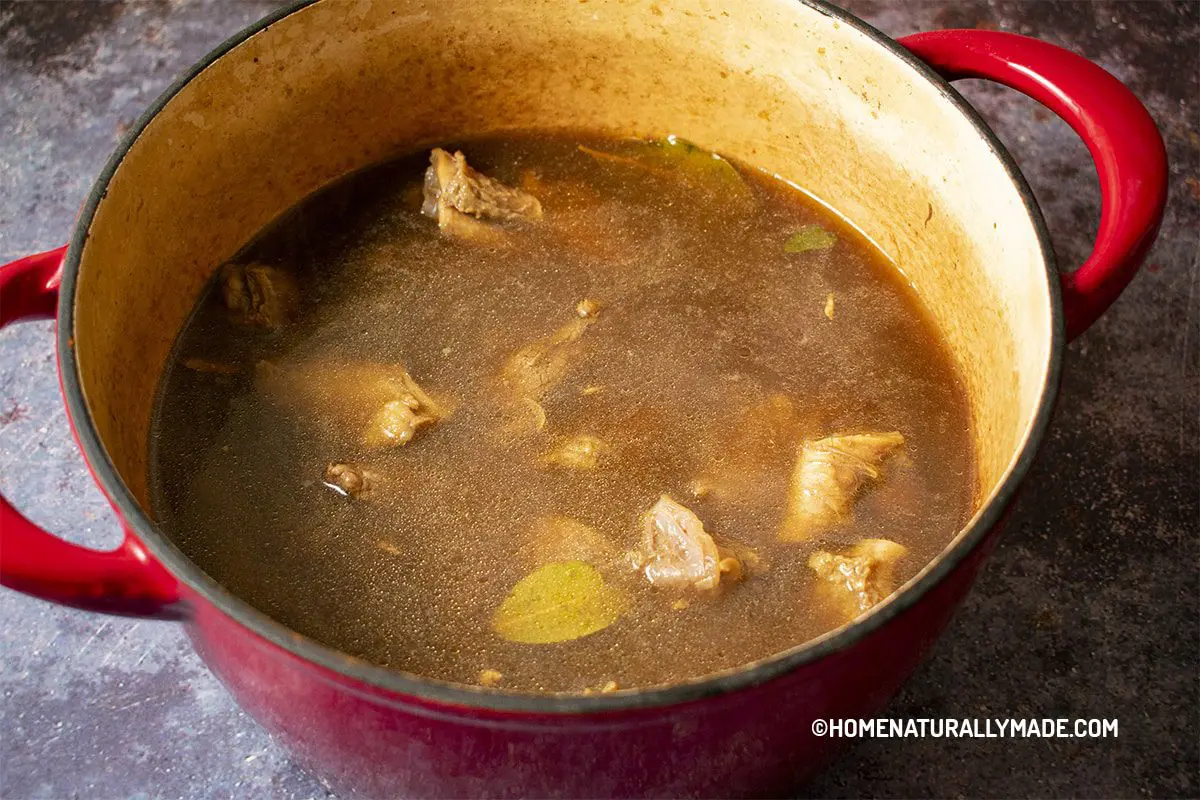
- Turn the heat to simmer and cook for 1.5 hours. Stir and mix well everything in the dutch oven every 30 minutes.
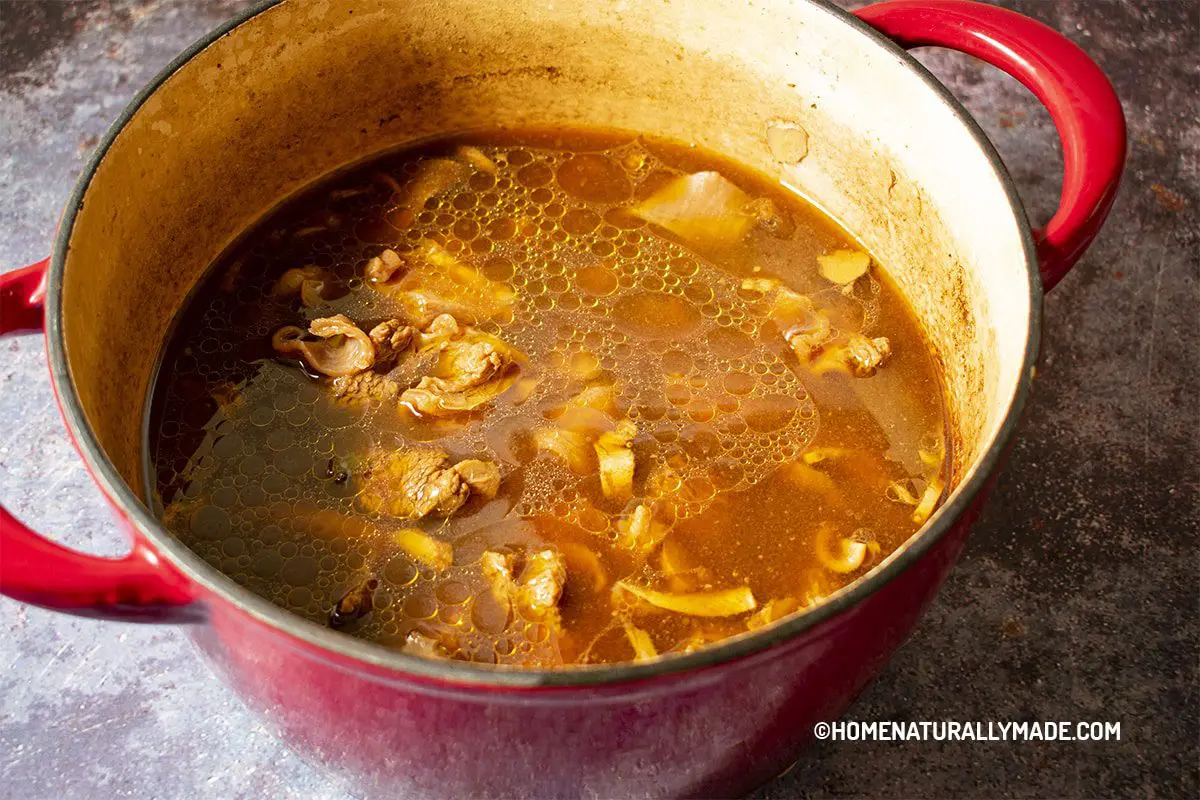
- Add the daikon radish, fold them into the beef and broth, cover the pot with the lid and simmer for 1.5 hours. Stir and mix well everything in the dutch oven every 30 minutes. The lid remains covered during the simmering process.
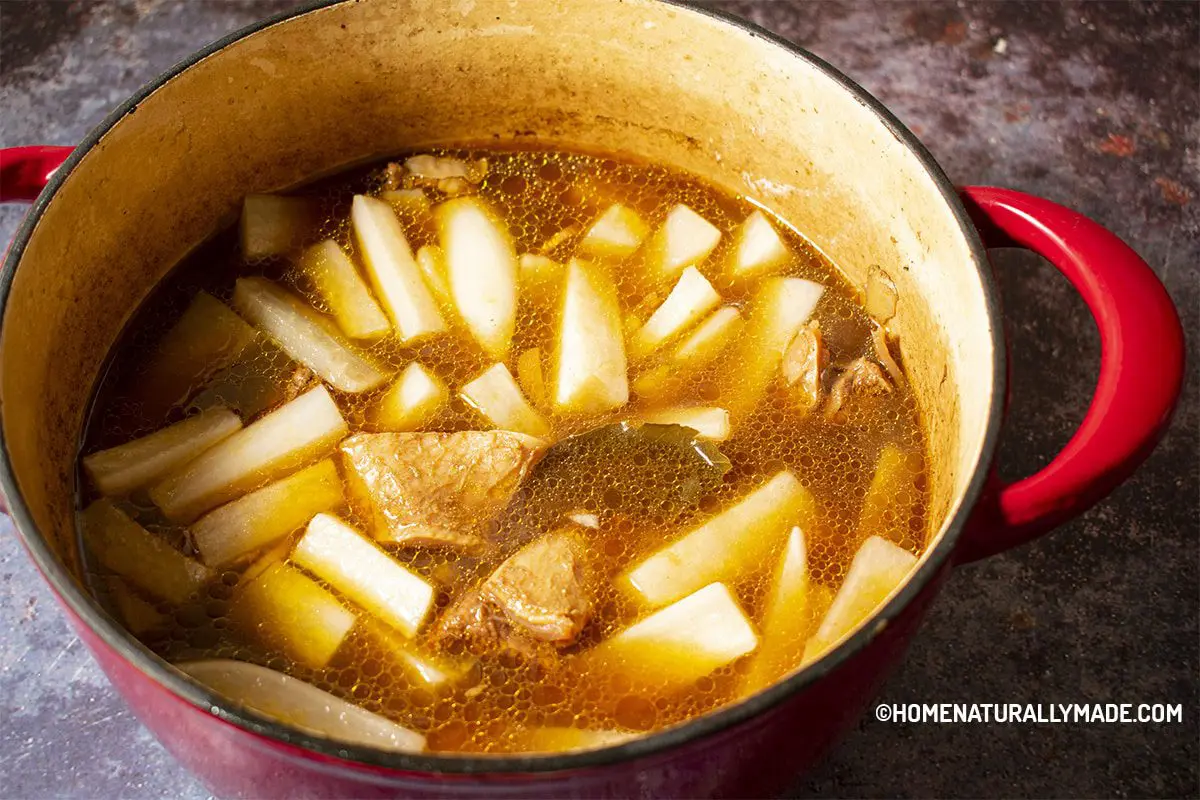
- Use a bamboo spatula to mix everything well in the dutch oven, turn the heat to medium-high, cover with the lid and cook for the last 10 minutes.

- All done! Enjoy a naturally delicious Luo Bo Niu Nan.

Recommended Products
As an Amazon Associate, I earn a small amount of commission from the qualifying purchases.
-
 Tea Kettle For Stove Top – Stainless Steel Tea Kettle Stovetop - Whistling Tea Kettle With Stay Cool Handle
Tea Kettle For Stove Top – Stainless Steel Tea Kettle Stovetop - Whistling Tea Kettle With Stay Cool Handle -
 8-Q Stockpot, Tramontina Stainless Steel Induction-Ready Tri-Ply Clad
8-Q Stockpot, Tramontina Stainless Steel Induction-Ready Tri-Ply Clad -
 OXO 1137680 Good Grips 3-Piece Peeler Set Green/Orange/Red, 10-inch
OXO 1137680 Good Grips 3-Piece Peeler Set Green/Orange/Red, 10-inch -
 Solid Stainless Steel Spider Strainer Skimmer
Solid Stainless Steel Spider Strainer Skimmer -
 Chinese Traditional Handmade Meat Cleaver
Chinese Traditional Handmade Meat Cleaver -
 Large Acacia Wood Cutting Board
Large Acacia Wood Cutting Board -
 Glass Mixing Bowls
Glass Mixing Bowls -
 Organic Cane Sugar
Organic Cane Sugar -
 Bay Leaves
Bay Leaves -
 Soeos Whole Black Peppercorns 18OZ + Himalayan Salt 38oz + Grinders 2 Packs.
Soeos Whole Black Peppercorns 18OZ + Himalayan Salt 38oz + Grinders 2 Packs. -
 Soeos Premium Sichuan Chili Powder 8oz(226g), All Natural
Soeos Premium Sichuan Chili Powder 8oz(226g), All Natural -
 Organic Cinnamon Powder
Organic Cinnamon Powder -
 Coffee/Spice Grinder
Coffee/Spice Grinder -
 Star Anise Seeds
Star Anise Seeds -
 Light Soy Sauce
Light Soy Sauce -
 Wan Ja Shan Naturally Brewed Soy Sauce (2 Pack, Total of 33.8fl.oz)
Wan Ja Shan Naturally Brewed Soy Sauce (2 Pack, Total of 33.8fl.oz) -
 Shaoxing Wine
Shaoxing Wine -
 Bamboo Spoons & Spatula
Bamboo Spoons & Spatula -
 8 Qt cast iron dutch oven pot
8 Qt cast iron dutch oven pot
Nutrition Information
Yield 6 Serving Size 1Amount Per Serving Calories 475Total Fat 28gSaturated Fat 11gTrans Fat 0gUnsaturated Fat 13gCholesterol 160mgSodium 754mgCarbohydrates 7gFiber 2gSugar 3gProtein 45g
Nutrition calculation is provided by Nutritionix to the best knowledge per ingredients description and isn't always accurate.
